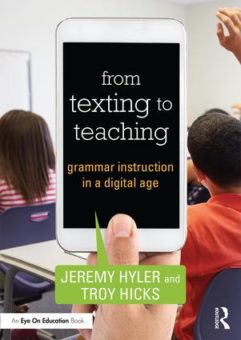How to Teach Grammar in the Digital Age
From Texting to Teaching: Grammar Instruction in a Digital Age
By Jeremy Hyler and Troy Hicks
(Routledge/Eye on Education, 2017 – Learn more)

Have you bounced from error analysis to Daily Grammar Practice to the sentence composing method without feeling like your students are really grasping grammar concepts, much less applying them to their writing?
Do you feel like your class time could be better used conferring with students about their writing rather than reviewing grammar concepts they should’ve already mastered? Do you feel like technology, including students’ mobile devices, could be used to do more than hook their interest?

Rethinking grammar in the classroom
The book’s goal is to motivate teachers to re-think the way we’re teaching grammar. Throughout the book, Hyler and Hicks argue that grammar instruction can be meaningful for students, though not the way grammar has been (and often is still being) taught – in isolation, disconnected from students’ real life spaces.
The authors’ solution to the disconnect: to purposefully introduce technology into the grammar class, using Liz Kolb’s Triple E Framework for technology integration to determine whether and to what degree tools engage, enhance, or extend student learning.
Hyler and Hicks divide the book into 7 chapters, starting with an overview of how grammar has been taught over the last 130 years, then going into specific tools for teaching different aspects of language conventions, and concluding with ideas on assessment:
- What’s the Matter with the Teaching of Grammar?
- An Approach to Teaching Grammar with Digital Tools
- Learning the Parts of Speech with Flipped Lessons
- Learning Sentence Style with Formal and Informal Writing
- Enlivening Vocabulary
- Mastering Mechanics: Capitalization and Punctuation
- Assessing Grammar in a Digital Age
Many teachers were taught grammar in isolation and were bored by a “drill and kill” approach. Then they became teachers and adopted the same instructional approach because that’s what they knew. This resonated with me. Though I’ve long since moved away from worksheets and have pulled sentences from students’ independent reading texts, I haven’t seen in-depth analysis of mentor texts or improvements in students’ writing.
Grammar in context
In Chapter 2, the authors argue that “more effective instruction involves students looking at grammar within the context of their writing and also seeing the moves other writers make through mentor texts. Then students take what they have learned and experiment with those moves themselves within their own writing” (p. 24).
As we push students beyond just identifying parts of speech and types of sentences, they must think about the audience and purpose of the mentor texts on a deeper level. I appreciated the authors’ insistence that we keep searching for better ways of facilitating students’ interactions with high quality mentor texts, regardless of how we were taught or how others continue to teach.
Flexibility and persistence
One question stood out to me as I worked on my unit plans for the upcoming school year: “What does a grammatically astute writer look and act like in the digital world?” (p. 24). Flexibility and persistence in navigating between formal and informal writing are the traits that came up repeatedly. To move students toward these traits, Hyler and Hicks suggest the following:
- admitting that we, as teachers, don’t fully understand all technology tools in existence (Chapter 2),
- flipping our classrooms by posting informational videos for students to engage with outside of class and then encouraging them to look up more information independently (Chapter 3),
- providing students with opportunities to make up assignments so that they get to access the concepts, even if all other students have moved on (Chapter 3),
- giving students opportunities to use online tools to manipulate language in the form of sentence strips, text message exchanges, or social media posts (Chapter 4),
- giving students opportunities to present information to their peers in the form of original videos (Chapter 5), and
- inviting students to use technology responsibly and trusting that they’ll do so (Chapter 6).
Suggested tools to use
I’m a teacher who loves technology and I don’t think it’s to blame for students’ grammar struggles. But I have been uncertain about how much responsibility my students can handle when it comes to technology use. With that in mind, I’ve decided to take the authors’ advice by selecting two new technology tools to integrate into my classroom this school year: Lino and Twitter (p. 121).
- Lino allows students to manipulate a sentence similar to sentence strips. It seems to appeal to middle schoolers’ desire not to copy down something incorrectly as they can continue moving around sentence chunks until they’ve gotten them arranged “just right.” Then, they can share what they’ve come up with in a text message exchange or social media post template.
- Twitter focuses students’ attention on the value of each word as it limits them to 140 characters per post. I’ve held back from using Twitter, thinking that I’d have to have all students on the site. Instead, Rather than all or nothing, Hyler and Hicks suggest sending home a technology letter at the beginning of the school year and having students use a fake Twitter template if their parents don’t give them permission to get online.
I also plan to use Google Docs in a new way. I’ve been having students share individual Google Docs with me at the start of each new assignment. Now I’ll have students share a digital folder with me at the start of school and then place their notes and drafts in it throughout the year in the form of a portfolio. This will save me time and frustration.
I couldn’t have picked this book up at a better time! It led me to think about technology tools strategically and inspired me to sit down and overhaul my website, adding a grammar and vocabulary page to each course section. So, IMHO, this book was GR8. FWIW, HTH. BFN, IYKWIM.
Desiree Tabor Carter (@DTaborCarter) teaches seventh grade English and yearbook journalism at The Museum School of Avondale Estates, a K-8 charter school in Atlanta, GA. She moved to middle grades last year after teaching high school for 7 years. She’s developed curriculum for a writing course, copy edited book chapters, and reveled in seeing her students get published.






























The digital age helps me teach grammar with applications and online services. Today’s children are rarely interested in writing rules, but they can easily digest information electronically. For example, I use resources from this list: https://www.englishhints.com/grammar-practice.html I give my students online practice tasks. Surprisingly, this gives really good results. Because it helps my students to learn for themselves.
Thank you, you also gave me some useful applications.